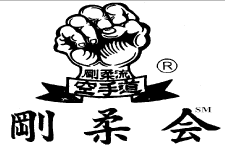Current capital city Naha in Okinawa was a
principal port city. It was Shuri where the king presided and was old capital city before
a US military base occupied the island.
There were three epochs mentioned with three
masters respectively in their evolution in the history of Goju-Ryu school. First was the
time when the school was known only as Naha Te of Kanryo Higaonna during 1870s of which
time the islanders were forced to surrender their nationality as Japanese. Second was when
the school was named Goju-Ryu by the group headed by Chojun Miyagi during 1930s of which
time Japan engaged in the Wrold War II. The third and final time period was when the
national structure of Goju-Ryu organization was established in mainland Japan by Gogen
Yamaguchi during the post war period. The organization has been called Karate-Do Goju-Kai
since that time.
Go, or means "hard" and Ju, or
_ means soft, thus idiom Goju, or _ suggest any variation of hard and soft aspect
in that school. As for a historical point of view a major body of system was imported from
Fukien Province in China. That system called itself one half hard and one soft style in
Chinese. The system also called Fukien Crain Chuan, ß which was branched school
from Five Ancestor Chuan Üc.
Kanryo Higaonna, ¶[ °Ê (1852-1915)
may be the earliest master who can be traced back in the history and who founded a
background of Goju-Ryu system. The system was called Naha-Te. Prior to Higaonna, there was
another master named Seiso Aragaki, V_¢@ (1840-1920) recognized as a Naha-Te
master. He was known as a master introduced kata Seisan.

